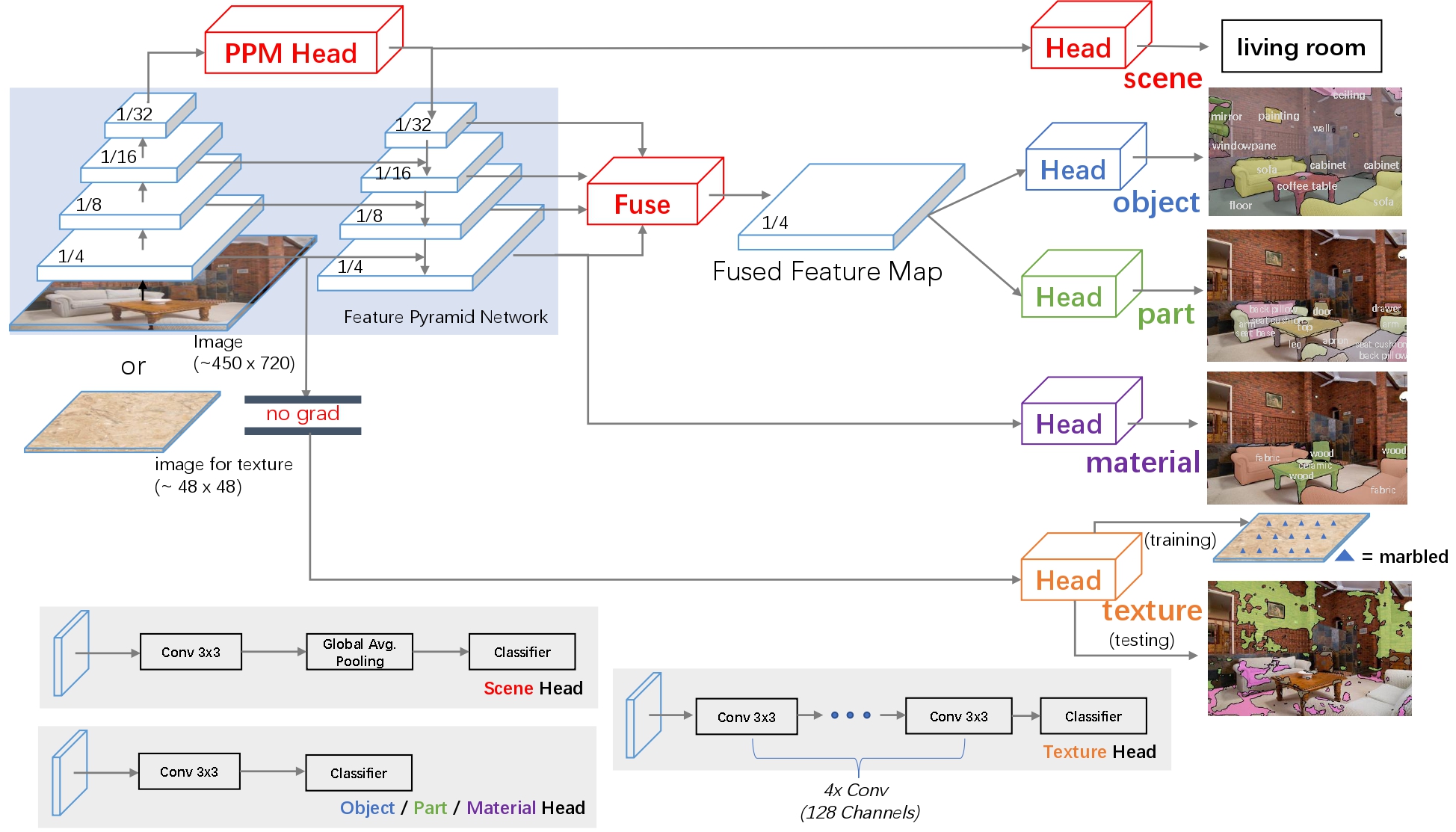# UPerNet
## Overview
The UPerNet model was proposed in [Unified Perceptual Parsing for Scene Understanding](https://arxiv.org/abs/1807.10221)
by Tete Xiao, Yingcheng Liu, Bolei Zhou, Yuning Jiang, Jian Sun. UPerNet is a general framework to effectively segment
a wide range of concepts from images, leveraging any vision backbone like [ConvNeXt](convnext) or [Swin](swin).
The abstract from the paper is the following:
*Humans recognize the visual world at multiple levels: we effortlessly categorize scenes and detect objects inside, while also identifying the textures and surfaces of the objects along with their different compositional parts. In this paper, we study a new task called Unified Perceptual Parsing, which requires the machine vision systems to recognize as many visual concepts as possible from a given image. A multi-task framework called UPerNet and a training strategy are developed to learn from heterogeneous image annotations. We benchmark our framework on Unified Perceptual Parsing and show that it is able to effectively segment a wide range of concepts from images. The trained networks are further applied to discover visual knowledge in natural scenes.*
 UPerNet framework. Taken from the original paper.
This model was contributed by [nielsr](https://huggingface.co/nielsr). The original code is based on OpenMMLab's mmsegmentation [here](https://github.com/open-mmlab/mmsegmentation/blob/master/mmseg/models/decode_heads/uper_head.py).
## Usage examples
UPerNet is a general framework for semantic segmentation. It can be used with any vision backbone, like so:
```py
from transformers import SwinConfig, UperNetConfig, UperNetForSemanticSegmentation
backbone_config = SwinConfig(out_features=["stage1", "stage2", "stage3", "stage4"])
config = UperNetConfig(backbone_config=backbone_config)
model = UperNetForSemanticSegmentation(config)
```
To use another vision backbone, like [ConvNeXt](convnext), simply instantiate the model with the appropriate backbone:
```py
from transformers import ConvNextConfig, UperNetConfig, UperNetForSemanticSegmentation
backbone_config = ConvNextConfig(out_features=["stage1", "stage2", "stage3", "stage4"])
config = UperNetConfig(backbone_config=backbone_config)
model = UperNetForSemanticSegmentation(config)
```
Note that this will randomly initialize all the weights of the model.
## Resources
A list of official Hugging Face and community (indicated by 🌎) resources to help you get started with UPerNet.
- Demo notebooks for UPerNet can be found [here](https://github.com/NielsRogge/Transformers-Tutorials/tree/master/UPerNet).
- [`UperNetForSemanticSegmentation`] is supported by this [example script](https://github.com/huggingface/transformers/tree/main/examples/pytorch/semantic-segmentation) and [notebook](https://colab.research.google.com/github/huggingface/notebooks/blob/main/examples/semantic_segmentation.ipynb).
- See also: [Semantic segmentation task guide](../tasks/semantic_segmentation)
If you're interested in submitting a resource to be included here, please feel free to open a Pull Request and we'll review it! The resource should ideally demonstrate something new instead of duplicating an existing resource.
## UperNetConfig
[[autodoc]] UperNetConfig
## UperNetForSemanticSegmentation
[[autodoc]] UperNetForSemanticSegmentation
- forward
UPerNet framework. Taken from the original paper.
This model was contributed by [nielsr](https://huggingface.co/nielsr). The original code is based on OpenMMLab's mmsegmentation [here](https://github.com/open-mmlab/mmsegmentation/blob/master/mmseg/models/decode_heads/uper_head.py).
## Usage examples
UPerNet is a general framework for semantic segmentation. It can be used with any vision backbone, like so:
```py
from transformers import SwinConfig, UperNetConfig, UperNetForSemanticSegmentation
backbone_config = SwinConfig(out_features=["stage1", "stage2", "stage3", "stage4"])
config = UperNetConfig(backbone_config=backbone_config)
model = UperNetForSemanticSegmentation(config)
```
To use another vision backbone, like [ConvNeXt](convnext), simply instantiate the model with the appropriate backbone:
```py
from transformers import ConvNextConfig, UperNetConfig, UperNetForSemanticSegmentation
backbone_config = ConvNextConfig(out_features=["stage1", "stage2", "stage3", "stage4"])
config = UperNetConfig(backbone_config=backbone_config)
model = UperNetForSemanticSegmentation(config)
```
Note that this will randomly initialize all the weights of the model.
## Resources
A list of official Hugging Face and community (indicated by 🌎) resources to help you get started with UPerNet.
- Demo notebooks for UPerNet can be found [here](https://github.com/NielsRogge/Transformers-Tutorials/tree/master/UPerNet).
- [`UperNetForSemanticSegmentation`] is supported by this [example script](https://github.com/huggingface/transformers/tree/main/examples/pytorch/semantic-segmentation) and [notebook](https://colab.research.google.com/github/huggingface/notebooks/blob/main/examples/semantic_segmentation.ipynb).
- See also: [Semantic segmentation task guide](../tasks/semantic_segmentation)
If you're interested in submitting a resource to be included here, please feel free to open a Pull Request and we'll review it! The resource should ideally demonstrate something new instead of duplicating an existing resource.
## UperNetConfig
[[autodoc]] UperNetConfig
## UperNetForSemanticSegmentation
[[autodoc]] UperNetForSemanticSegmentation
- forward

 UPerNet framework. Taken from the original paper.
This model was contributed by [nielsr](https://huggingface.co/nielsr). The original code is based on OpenMMLab's mmsegmentation [here](https://github.com/open-mmlab/mmsegmentation/blob/master/mmseg/models/decode_heads/uper_head.py).
## Usage examples
UPerNet is a general framework for semantic segmentation. It can be used with any vision backbone, like so:
```py
from transformers import SwinConfig, UperNetConfig, UperNetForSemanticSegmentation
backbone_config = SwinConfig(out_features=["stage1", "stage2", "stage3", "stage4"])
config = UperNetConfig(backbone_config=backbone_config)
model = UperNetForSemanticSegmentation(config)
```
To use another vision backbone, like [ConvNeXt](convnext), simply instantiate the model with the appropriate backbone:
```py
from transformers import ConvNextConfig, UperNetConfig, UperNetForSemanticSegmentation
backbone_config = ConvNextConfig(out_features=["stage1", "stage2", "stage3", "stage4"])
config = UperNetConfig(backbone_config=backbone_config)
model = UperNetForSemanticSegmentation(config)
```
Note that this will randomly initialize all the weights of the model.
## Resources
A list of official Hugging Face and community (indicated by 🌎) resources to help you get started with UPerNet.
- Demo notebooks for UPerNet can be found [here](https://github.com/NielsRogge/Transformers-Tutorials/tree/master/UPerNet).
- [`UperNetForSemanticSegmentation`] is supported by this [example script](https://github.com/huggingface/transformers/tree/main/examples/pytorch/semantic-segmentation) and [notebook](https://colab.research.google.com/github/huggingface/notebooks/blob/main/examples/semantic_segmentation.ipynb).
- See also: [Semantic segmentation task guide](../tasks/semantic_segmentation)
If you're interested in submitting a resource to be included here, please feel free to open a Pull Request and we'll review it! The resource should ideally demonstrate something new instead of duplicating an existing resource.
## UperNetConfig
[[autodoc]] UperNetConfig
## UperNetForSemanticSegmentation
[[autodoc]] UperNetForSemanticSegmentation
- forward
UPerNet framework. Taken from the original paper.
This model was contributed by [nielsr](https://huggingface.co/nielsr). The original code is based on OpenMMLab's mmsegmentation [here](https://github.com/open-mmlab/mmsegmentation/blob/master/mmseg/models/decode_heads/uper_head.py).
## Usage examples
UPerNet is a general framework for semantic segmentation. It can be used with any vision backbone, like so:
```py
from transformers import SwinConfig, UperNetConfig, UperNetForSemanticSegmentation
backbone_config = SwinConfig(out_features=["stage1", "stage2", "stage3", "stage4"])
config = UperNetConfig(backbone_config=backbone_config)
model = UperNetForSemanticSegmentation(config)
```
To use another vision backbone, like [ConvNeXt](convnext), simply instantiate the model with the appropriate backbone:
```py
from transformers import ConvNextConfig, UperNetConfig, UperNetForSemanticSegmentation
backbone_config = ConvNextConfig(out_features=["stage1", "stage2", "stage3", "stage4"])
config = UperNetConfig(backbone_config=backbone_config)
model = UperNetForSemanticSegmentation(config)
```
Note that this will randomly initialize all the weights of the model.
## Resources
A list of official Hugging Face and community (indicated by 🌎) resources to help you get started with UPerNet.
- Demo notebooks for UPerNet can be found [here](https://github.com/NielsRogge/Transformers-Tutorials/tree/master/UPerNet).
- [`UperNetForSemanticSegmentation`] is supported by this [example script](https://github.com/huggingface/transformers/tree/main/examples/pytorch/semantic-segmentation) and [notebook](https://colab.research.google.com/github/huggingface/notebooks/blob/main/examples/semantic_segmentation.ipynb).
- See also: [Semantic segmentation task guide](../tasks/semantic_segmentation)
If you're interested in submitting a resource to be included here, please feel free to open a Pull Request and we'll review it! The resource should ideally demonstrate something new instead of duplicating an existing resource.
## UperNetConfig
[[autodoc]] UperNetConfig
## UperNetForSemanticSegmentation
[[autodoc]] UperNetForSemanticSegmentation
- forward